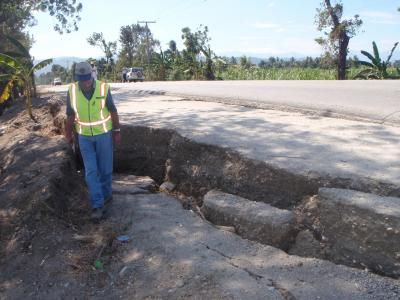
Hurricane-Caused Landslides May Trigger Earthquakes, Study Suggests

SAN FRANCISCO — Typhoons and hurricanes can trigger large earthquakes in tropical regions, a new study suggests.
By dumping rain and causing landslides, these storms can change the weight of the Earth in tectonically-stressed regions, releasing loads that had been keeping the faults locked in tight. The result is that faults already under pressure seem more likely to break in the years after very wet tropical cyclones.
Earthquakes including Haiti's 2010 magnitude-7.0 temblor and a 6.4-magnitude quake that struck Kaohsiung, Taiwan, the same year, fit this pattern, according to study researcher Shimon Wdowinski, a professor of marine geology and geophysics at the University of Miami. Wdowinski reported his findings here today (Dec. 8) at the annual meeting of the American Geophysical Union (AGU).
These quakes were preceded by drenching storms that wreaked other kinds of havoc.
"The cyclone itself is a disaster, there is a lot of flooding, then there are landslides and then the earthquakes come," Wdowinski said.
Disaster chain reaction
Wdowinski and his colleague Igor Tsukanov of Florida International University became interested in whether tropical cyclones interact with earthquakes after noticing that both the 2010 Taiwan earthquake and the 2010 Haiti quake were preceded relatively closely by big storms. In the case of Taiwan, 2008's Typhoon Morakot had dumped 115 inches (292 centimeters) of rain in just five days. In the case of the Haiti quake, the 2008 hurricane season had been brutal, with named storms (hurricanes and tropical storms) Fay, Gustav, Hanna and Ike tearing into the island. [Images of Haiti Quake Aftermath]
Sign up for the Live Science daily newsletter now
Get the world’s most fascinating discoveries delivered straight to your inbox.
The researchers decided to see if the timing was a coincidence or whether it meant something more. They turned to Taiwan, which has good records of the past 50 years of quakes and storms.
Focusing only on very wet typhoons with the capacity to cause of a lot of erosion, and removing aftershocks that would bias the analysis, the researchers found that 85 percent of magnitude-6-and-above quakes occurred within the first four years after a very wet storm. That was five times what would have been expected from background quake rates, Wdowinski said.
Even smaller quakes followed the same pattern, with 35 percent of magnitude-5-and-above quakes occurring within the first four years after wet storms — twice the expected number.
Timing is everything
Previous researchers have suggested that extremely low pressure from storms can trigger quakes in already-strained areas in the very short term, Wdowinski said, but these longer-term linkages are likely caused by a different mechanism. These areas are already tectonically active, with faults building up strain as landmasses creep against one another. These strained faults are destined to rupture and eventually cause quakes, Wdowinski said.
But when a very wet typhoon or hurricane dumps lots of rain, it often causes large landslides in mountainous areas. Extra rain over the following months further erodes mountains and hills scarred by these landslides. This shifting of sediment lifts the weight that keeps faults locked. The burden lifted, the fault suddenly slips, causing a quake.
These quakes are likely not any larger or smaller than they otherwise would have been, Wdowinski said, but the presence of very wet storms may give a hint that a quake-prone region is at higher risk of rupturing in the following years.
"The main engine that's actually responsible for the earthquake is not the wet typhoon," Wdowinski said. "The wet typhoon just determines the timing."
You can follow LiveScience senior writer Stephanie Pappas on Twitter @sipappas. Follow LiveScience for the latest in science news and discoveries on Twitter @livescienceand on Facebook.

Stephanie Pappas is a contributing writer for Live Science, covering topics ranging from geoscience to archaeology to the human brain and behavior. She was previously a senior writer for Live Science but is now a freelancer based in Denver, Colorado, and regularly contributes to Scientific American and The Monitor, the monthly magazine of the American Psychological Association. Stephanie received a bachelor's degree in psychology from the University of South Carolina and a graduate certificate in science communication from the University of California, Santa Cruz.










